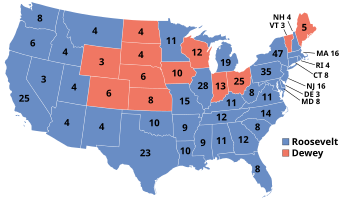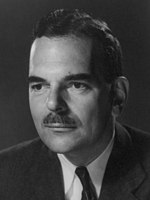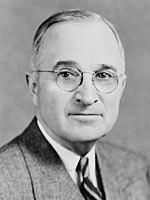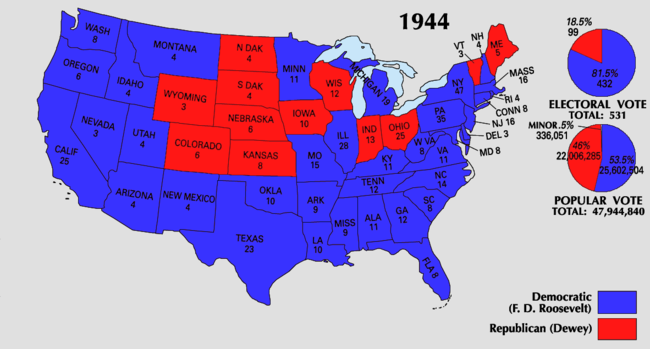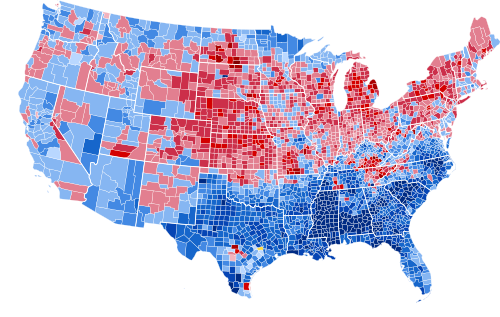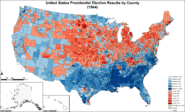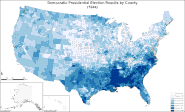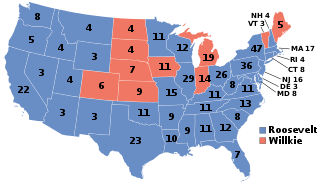
The 1940 United States presidential election was the 39th quadrennial presidential election. It was held on Tuesday, November 5, 1940. Incumbent Democratic President Franklin D. Roosevelt defeated Republican businessman Wendell Willkie to be reelected for an unprecedented third term in office. Until 1988, this was the last time in which the incumbent's party won three consecutive presidential elections. It was also the fourth presidential election in which both major party candidates were registered in the same home state; the others have been in 1860, 1904, 1920, 1944, and 2016.

The 1948 United States presidential election was the 41st quadrennial presidential election. It was held on Tuesday, November 2, 1948. In one of the greatest election upsets in American history, incumbent Democratic President Harry S. Truman defeated heavily favored Republican New York Governor Thomas E. Dewey, and third-party candidates, becoming the third president to succeed the presidency upon his predecessor's death and be elected to a full term.

The 1944 United States elections was held on November 7, 1944, during the final stages of World War II. President Franklin D. Roosevelt was easily re-elected to an unprecedented fourth term, and the Democratic Party retained their majorities in both chambers of Congress.

The 1948 United States presidential election in New York took place on November 2, 1948. All contemporary 48 states were part of the 1948 United States presidential election. Voters chose 47 electors to the Electoral College, which selected the president and vice president.

The 1944 United States presidential election in New York took place on November 7, 1944. All contemporary 48 states were part of the 1944 United States presidential election. Voters chose 47 electors to the Electoral College, which selected the president and vice president.

The 1948 United States presidential election in Massachusetts took place on November 2, 1948, as part of the 1948 United States presidential election, which was held throughout all contemporary 48 states. Voters chose 16 representatives, or electors to the Electoral College, who voted for president and vice president.

The 1944 United States presidential election in Massachusetts took place on November 7, 1944, as part of the 1944 United States presidential election, which was held throughout all contemporary 48 states. Voters chose 16 representatives, or electors to the Electoral College, who voted for president and vice president.

The 1948 United States presidential election in Vermont took place on November 2, 1948, as part of the 1948 United States presidential election which was held throughout all contemporary 48 states. Voters chose three representatives, or electors to the Electoral College, who voted for president and vice president.

The 1944 United States presidential election in Vermont took place on November 7, 1944, as part of the 1944 United States presidential election which was held throughout all 48 states. Voters chose three representatives, or electors to the Electoral College, who voted for president and vice president.

The 1944 United States presidential election in New Jersey took place on November 7, 1944. All contemporary 48 states were part of the 1944 United States presidential election. Voters chose 16 electors to the Electoral College, which selected the president and vice president.

The 1948 United States presidential election in New Hampshire took place on November 2, 1948, as part of the 1948 United States presidential election, which was held throughout all contemporary 48 states. Voters chose four representatives, or electors to the Electoral College, who voted for president and vice president.

The 1948 United States presidential election in Wisconsin was held on November 2, 1948, as part of the 1948 United States presidential election. State voters chose 12 electors to the Electoral College, who voted for president and vice president.

The 1944 United States presidential election in South Carolina took place on November 7, 1944, as part of the 1944 United States presidential election. State voters chose 8 electors to the Electoral College, which selected the president and vice president.
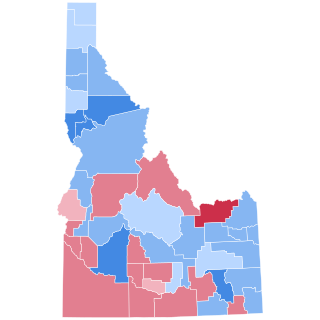
The 1948 United States presidential election in Idaho took place on November 2, 1948, as part of the 1948 United States presidential election. State voters chose four representatives, or electors, to the Electoral College, who voted for president and vice president.

The 1944 United States presidential election in Wyoming took place on November 7, 1944, as part of the 1944 United States presidential election. State voters chose three representatives, or electors, to the Electoral College, who voted for president and vice president.

The 1948 United States presidential election in Wyoming took place on November 2, 1948, as part of the 1948 United States presidential election. State voters chose three representatives, or electors, to the Electoral College, who voted for president and vice president. Wyoming was won by incumbent Democratic President Harry S. Truman, running with Senate Majority Leader Alben W. Barkley, with 51.62 percent of the popular vote, against the Republican nominee, 47th Governor of New York Thomas E. Dewey, running with California Governor and future Chief Justice of the United States Earl Warren, with 47.27 percent of the popular vote, despite the fact that Dewey had previously won the state four years earlier.

The 1944 United States presidential election in Alabama took place on November 7, 1944, as part of the 1944 United States presidential election. Alabama voters chose eleven representatives, or electors, to the Electoral College, who voted for president and vice president.
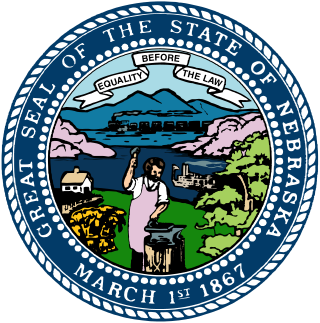
The 1944 United States presidential election in Nebraska took place on November 7, 1944, as part of the 1944 United States presidential election. Voters chose six representatives, or electors, to the Electoral College, who voted for president and vice president.
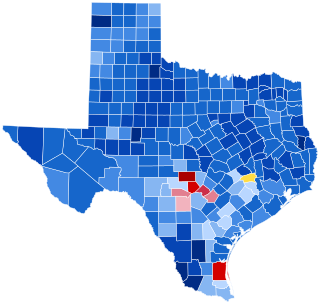
The 1944 United States presidential election in Texas took place on November 7, 1944, as part of the 1944 United States presidential election. State voters chose 23 electors to represent the state in the Electoral College, which chose the president and vice president.

The 1944 United States presidential election in North Carolina took place on November 7, 1944, as part of the 1944 United States presidential election. North Carolina voters chose 14 representatives, or electors, to the Electoral College, who voted for president and vice president.
